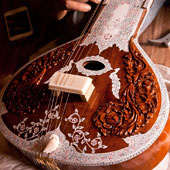The most important step in making of Sitar is the selection of raw material used for the process. From centuries teak wood was preferred for the making of sitar, nowadays Indian rose wood or tun wood is used due to the non- availability of teak. Depending on the trunk diameter of the tree well- seasoned wood is selected, generally all the parts of sitar are extracted from a single wooden trunk. Selected wooden trunk is processed in saw mill and parts of the sitar like Dandi, Pta, Tabli, Gullu and Tumba are segregated.
In general the length of sitar is about 4 feet (1.2 meters) and it differs from instrument to instrument, Dandi is the neck of sitar which is carved from a single wooden piece that is hollow in an arc shape in the middle and covered with pta as top cover. Totally dandi consists of 6 different parts which include two camel bone bridge known as patri, arda-patri (that are placed opposite to each other with a gap of half an inch), strings, pta, frets and tuning pegs.
The resonator (tumba) is generally made out of tumba gourd, which is mostly cultivated at the banks of Bhima River. The size of tumba determines the length of sitar, the gourds with ideal shape and size are required for a good quality sitar. Selection of gourd (size should be not too thick/thin or dense/heavy) plays a very important role which determines the overall sound quality. Only best gourds with smooth and well composed skin with minimum flaws are used as resonator.
Usually large size gourd is preferred for the professional sitars. To make tumba, the top portion of gourd is cut and the material (pulp) inside is removed. The gourd is soaked in water for few hours that gives it a consistency of thick leather. Bamboo or tun stick is used to give support from inside which is placed at accurate point (place inside), that helps in the shaping of tumba. Gullu (part which connects tumba and dandi together) is fasten to the dried and shaped tumba using nails, carved part of the dandi is attached to gullu. All the body parts of sitar is glued together with the help of charcoal and local adhesive mixture and allowed to set. As a part of final shaping and finishing process, sitar is rasped, filed and sanded for smooth finish.
Decoration (carving) is done for which the celluloid membrane is coated onto the surface of sitar, and generally white color membrane is preferred by the craftsmen to which intricate carving is carried out. Floral design is one of the most common carving seen on professional sitar, in few designs carving is made of surface of wood rather than celluloid. Tail pieces of sitar are made of tun wood and in the case of fancy sitar, it is made up of stag horn which is added after polishing unlike tun wood.
Traditionally, shellac polish (which is usually made of resin secreted by the female lac bug) was used to coat sitar that used to take about 2 to 3 days to dry, nowadays varnish is used due to availability as it dries faster. Parts like kunti (tuning pegs), jiwari (main bridges), parda (fret), targen (nuts) and other small pieces are fasten to polished sitar. In few of the selected design secondary gourd is added on the specification by costumer. It is believed by some professional musicians, that secondary gourd also acts like a resonator and helps in total sound quality.
Kunti were made of rose wood (depending on the availability) that had blank or plane surface. Designed or carved kunti were only made (as rose wood is hard to carve manually) to add value to sitar and also for musician of high respect. However in modern times with the help of automated tools it is generally seen on costly sitar and Kunti’s are attached to the left side on dandi. Jiwari is made out of camel bone that is wide and slightly carved on top. It is fixed on top of tabli (cover of tumba) which helps in tonal enhancement.
Frets are positioned on top of dandi which are tied using nylon threads, these frets are adjustable unlike in veena which are fixed. Brass strings are attached to kunti that vary in number from 18, 19 and 20. Generally, there are 13 sympathetic strings which are tuned of raga, 5 melody string and 1 or 2 drone string used for emphasize on rhythm.
























